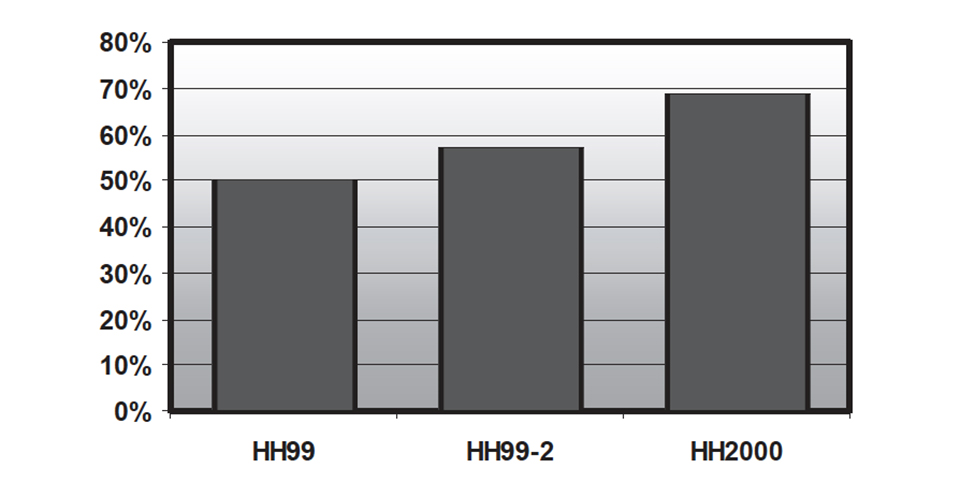Over three rounds of selection, mean survival steadily increased
High Health Aquaculture, Inc. (HHA), a shrimp breeding company located in Kona, Hawaii, has been working on developing shrimp resistant to the Taura Syndrome Virus (TSV) since 1994. We carry out a selective breeding program to develop TSV-resistant L. vannamei, with the goal of developing fast growing, disease resistant shrimp that minimize risk of disease and maximize profits in culture. All of our stocks, including (L. vannamei, L. stylirostris and P. monodon), are certified virus-free. I
n our first two rounds of selection for TSV resistance, our selected L. vannamei groups had significantly higher survival than non-selected groups. Details of those experiments are published in the Proceedings of the First Latin American Shrimp Culture Conference, held in Panama on October 1998 (available at: info@gfce.com)
We completed our third round of selection for TSV resistance in the spring of 1999. Tagged juveniles were shipped live to Tucson (Arizona), where the Aquaculture Pathology Lab at the University of Arizona conducted the TSV-challenge. Our select L. vannamei group (called HH2000) averaged 69 percent survival, compared to a 31 percent survival average for the non-select group. Over the three rounds of selection we have completed, the mean survival of our select groups has steadily increased (Fig. 1). These data indicate that our selective breeding program for TSV-resistance is making good progress towards our goal.

Field data from use of our select stocks in 1999 is now available from Texas. Broodstock produced from our HH99 select group were supplied to Harlingen Shrimp Farm, the leading shrimp hatchery in the U.S. They used the HH99 broodstock to produce PL to supply the U.S. industry in 1999.
Harvest data from Texas indicate that the HH99 offspring displayed outstanding growth rates, reaching mean harvest sizes of 22 to 25 grams. Harvest survivals in TSV-free farms in South Texas were 70-80 percent. Harvest survivals in TSV-positive farms in North Texas were in the 30 to 50 percent range. Farmers report that these growth rates and survivals are well above those recorded in 1998, and are strong encouragement to restock High Health shrimp in the future. Overall, the 1999 farmed shrimp crop in Texas reached levels comparable to pre-TSV years for the first time since the disease appeared.
The increasing survivals of HHA’s select groups in lab challenges combined with the improved survivals and growth rates in Texas shrimp farms using HHA’s selected stocks, indicate that we are making significant progress towards our goals of developing a fast growing TSV-resistant L. vannamei.
(Editor’s Note: This article was originally published in the December 1999 print edition of the Global Aquaculture Advocate.)
Now that you've finished reading the article ...
… we hope you’ll consider supporting our mission to document the evolution of the global aquaculture industry and share our vast network of contributors’ expansive knowledge every week.
By becoming a Global Seafood Alliance member, you’re ensuring that all of the pre-competitive work we do through member benefits, resources and events can continue. Individual membership costs just $50 a year. GSA individual and corporate members receive complimentary access to a series of GOAL virtual events beginning in April. Join now.
Not a GSA member? Join us.
Author
-
James Wyban
Kona, Hawaii USA
Tagged With
Related Posts

Health & Welfare
Blue alternative: High Health introduces SPF blue shrimp to Thailand
Blue shrimp are very similar to Pacific white shrimp, and can be raised under similar conditions. Blues grow faster and tolerate lower water temperatures.

Health & Welfare
Colombian shrimp research associates TSV, NHP selection, resistance
In an NHP (necrotizing hepatopancreatitis) challenge test, shrimp from a Colombian breeding program had higher resistance and 30 percent greater survival than a control line of Taura syndrome virus-free shrimp.

Health & Welfare
Domestication of Pacific white shrimp revolutionizes aquaculture
The development of specific pathogen-free Pacific white shrimp and breeding led to rapid adoption of the domesticated shrimp throughout the Western Hemisphere and Asia.

Health & Welfare
Evolutionary history of Taura Syndrome Virus
Based on a phylogenetic analysis with the BEAST program, the authors determined the evolutionary relationships among 83 Taura syndrome virus isolates.


